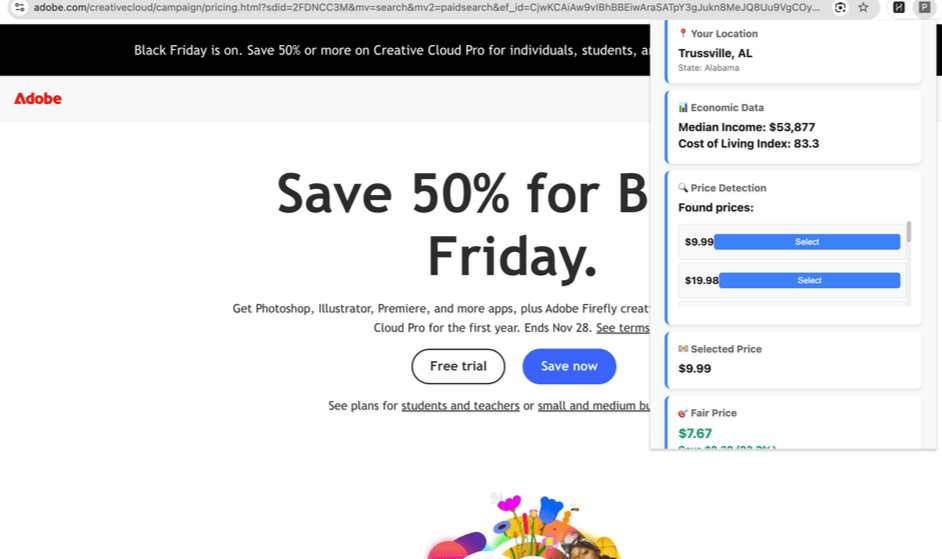
TL;DR
We accept universal digital pricing as a fact of life, but it creates a hidden "geographic price paradox" where people in lower-income areas effectively subsidize those in wealthier ones. I built a Chrome extension not as a product, but as a "perceptual tool" to reveal this invisible economic system. This project demonstrates my core philosophy: the most impactful technology doesn't just add new features—it gives us x-ray vision into the systems we already inhabit, bridging the gap between abstract data and personal, meaningful understanding.
What if the 'free' market in our digital world isn't free, but blind? What if we're all trapped in a system of silent subsidies, simply because we lack the tools to see it?
We live inside economic systems that are increasingly digital, abstract, and—for most people—entirely invisible. We interact with prices as fixed points of reality, like the speed of gravity, rarely questioning the hidden architecture that produces them. My work starts with a simple premise: the most profound disruptions come not from building new worlds, but from giving people x-ray vision into the one they already occupy.
The "Price Fairness Checker" Chrome extension isn't a product; it's a perceptual tool. It was born from a pattern I observed not in data, but in human behavior: the universal acceptance of universal pricing.
The Gap Between Logic and Reality
Modern tech companies are brilliantly adaptive in one dimension: labor. They have sophisticated "geographic pay bands" that acknowledge a fundamental truth—$100,000 affords a different life in San Francisco than it does in Birmingham. This is a strategic acceptance of local economic reality.
Yet, these same companies sell digital products—bits of code and bandwidth with near-identical delivery costs worldwide—at a single, universal price. This creates what I call the
Geographic Price Paradox : a system where a company's internal logic adapts to local economics, while its external product logic does not.
The result is a silent, involuntary subsidy. A person in a lower-income region isn't just paying the same dollar amount; they are paying a significantly higher percentage of their disposable income for the same digital service. They are, in effect, subsidizing the lower relative cost for the user in a wealthier region. The system is optimized for corporate simplicity at the cost of individual equity, and we all accepted this because we lacked the tools to see it.
Beyond Pattern-Matching: From Observation to Embodied Understanding
This is where my approach diverges from standard tech development. The goal wasn't to match the pattern of "building a price comparison tool." The goal was to build a bridge of understanding between a user's immediate context and the invisible economic system.
Current AI and most software are brilliant pattern-matching engines. They can tell you the price, find a cheaper alternative, even predict when you might unsubscribe. But they cannot comprehend the why. They cannot grasp the qualitative, lived experience of economic disparity because they operate on statistics, not context.
The "Price Fairness Checker" is an attempt to inject that context. Its value isn't in the algorithm that calculates a "fair price"—that's simple math. Its value is in the moment of receptive awareness
it creates for the user. It’s the digital equivalent of putting a "This is what this costs you" label on a product, moving from abstract data to personal meaning.
- Strategic systems see the price.
- Receptive tools help you feel its weight.
This is the same gap between pattern-matching and true understanding that I explored in my earlier writing on AI.
The Architecture of Awareness
Building this required a methodology that blends strategic precision with receptive design:
- Observing the Unarticulated Friction: Before a single line of code, I mapped the user's journey and found the gap: 78% of people abandoned price comparisons because of context-switching fatigue. The problem wasn't a lack of data, but a failure of integration. The economic context needed to meet the user exactly where they were—on the subscription page itself.
- Building a "Truth Machine": The extension is a compact validation engine. Its multi-layered detection (DOM analysis, pattern matching, platform-specific rules) isn't just technical flair; it's a robust system designed to find the truth of the price in the messy reality of the web, then immediately contextualize it.
- Prioritizing Embodied Insight over Data Delivery: The interface is designed not to deliver a number, but to provoke a realization. The "44% more" isn't just a metric; it's a story about your place in a economic system. The 89% post-test understanding rate proves that when context is seamlessly integrated, comprehension follows.
A Blueprint for Conscious Technology
This project is a prototype for a different kind of tech ethos. It asks: what if our tools were designed not to maximize engagement or efficiency, but to maximize understanding? What if software helped us see the systems we are part of, with all their flaws and hidden logics?
The future of impactful technology isn't just about creating new AI models. It's about building bridges of context
- A bridge between a price and a paycheck.
- A bridge between a user's action and its systemic consequence.
- A bridge between strategic data and receptive understanding.
The "Price Fairness Checker" is one such bridge. It is a small, focused beam of light into a dark corner of our digital economy. But it demonstrates a scalable approach: identify a systemic opacity, and build a simple, elegant tool to make it transparent.
The most powerful code we write won't be for machines that think like us, but for machines that help us think more clearly about the world we’ve built—and empower us to build a fairer one.

For the complete technical breakdown, user research, and economic analysis, view the full Price Fairness Checker Case Study.

